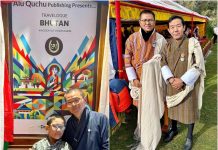“…and mellow fruitfulness” I hear you murmur. Or perhaps I don’t, if you are not familiar with the writings of John Keats. He was of course one of the great English Romantic poets, although he initially trained at Guy’s Hospital to become a surgeon. His short life was coloured by sadness. He was born in East London in 1795 but his father died after an accident when the boy was eight. His mother died of tuberculosis six years later. As a young adult, Keats went to Rome on medical advice in search of a warmer climate, but he too fell victim to tuberculosis on 23rd February, 1821. He was twenty-five.
Good heavens, this is a depressing start! Honestly, I don’t want to give you a fit of melancholia so early in the weekend. If you’re feeling a little bit down at the moment, it’s probably better if you skip this column altogether and come back next week. To be honest, the only reason I quote Keats is to set the scene for two orchestral pieces about autumn. You see, one day in 1819 Keats went for a country stroll near the old English town of Winchester and the poem entitled To Autumn was the result. It was published the same year and was one of his last.
 William Alwyn, a busy composer.
William Alwyn, a busy composer.
Although Keats was not much appreciated during his lifetime, by the end of the nineteenth century he had become one of the best loved of all English poets. But of course, things have a habit of changing. Last year, the BBC organised a poll in an attempt to discover Britain’s favourite poets. Amazingly, over eighteen thousand people voted but the once-popular Keats had fallen back to ninth place. And in case you’re wondering, the nation’s most popular poet – somewhat surprisingly – turned out to be T.S. Elliott.
Anyway, where were we? Ah yes, autumn. There’s lots of music inspired by autumn ever since Vivaldi wrote a concerto on the theme in his set of violin concertos collectively known as The Four Seasons. It’s perhaps the only classical work that might have inspired a pizza.
William Alwyn (1905-1985): Autumn Legend. Rebecca Van de Ven (cor anglais) Sewanee Summer Music Festival Chamber Ensemble. (Duration: 13:21; Video: 720p HD)
Born in Northampton, William Alwyn studied flute and composition at London’s Royal Academy of Music and later returned there as a professor of composition, a position which he held for nearly thirty years. He was also a flautist in the London Symphony Orchestra but he’s especially associated with film music because during his lifetime he wrote nearly two hundred film music scores. These included classic movies such as Odd Man Out, Desert Victory, Fires Were Started, The History of Mr. Polly, The Fallen Idol and The Crimson Pirate. Few people know that William Alwyn also wrote five symphonies, four operas, as well as several concertos and string quartets. As if that weren’t enough, he was also a poet and an artist. He couldn’t have had much spare time on his hands.
Autumn Legend dates from 1954 and is scored for cor anglais and small string orchestra. As you probably know, the cor anglais is a kind of tenor oboe and sometimes known as an English horn; a rather inappropriate name really because it’s neither English nor a horn. But music is full of inconsistencies. This short but expressive work has a Debussy-like impressionist feel to it; a season of mists indeed. The dark, plaintive tone-colour of the cor anglais, superbly played by Rebecca Van de Ven, brings reminders of that other evocative but somewhat gloomy work by Sibelius, The Swan of Tuonela.
Edvard Grieg (1843-1907): Overture – In Autumn, Op 11. Strathmere Festival Orchestra cond. Per Brevig. (Duration: 12:08; Video: 480p)
In contrast, Grieg’s vision of a Norwegian autumn is rather more joyous. On a visit to Copenhagen, the twenty-two year old Grieg showed the score of this overture to Niels Gade, the conductor, composer, violinist and organist who was considered the most influential Danish musician of his day. On seeing the music, Gade is said to have uncharitably remarked, “This is rubbish, Grieg. Go home and write something better.”
Grieg did indeed go home and recast the work as a piano duet. He entered the new arrangement in a competition organised by the Swedish Academy and – presumably to his delight – it won first prize. One of the judges was none other than Niels Gade who it should be added, later helped Grieg’s musical career and played a major role in bringing international recognition to Scandinavian music.
This splendidly-performed orchestral version dates from 1865 and it shows remarkable composing and orchestration skills. Although it’s a youthful work, it exudes infectious charm and has some lovely lyrical moments, finely-wrought melodies and a satisfyingly triumphant conclusion.




